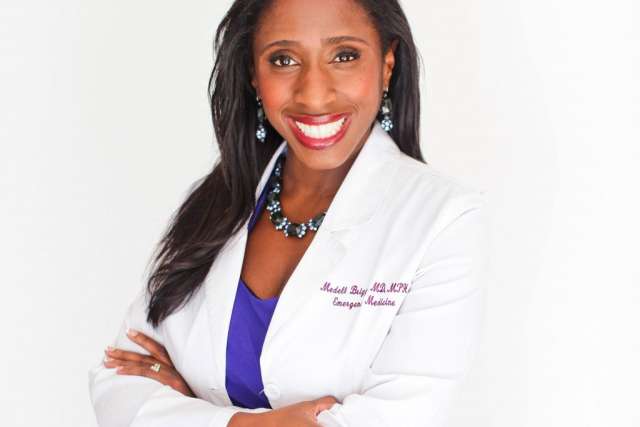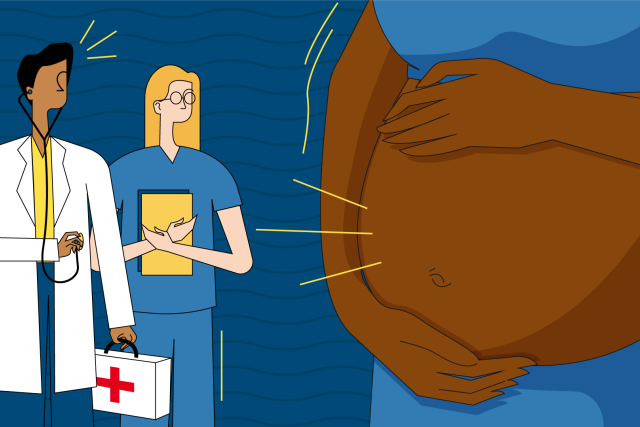Medell Briggs-Malonson was in labor with her first child, and something wasn’t right.
The fetal heart monitor in her hospital room showed that the baby’s heart rate was dropping precipitously low and hovering there before returning to normal.
Dr. Briggs-Malonson alerted the nurse, who reassured her that everything was fine as she gently fluffed up the pillows behind the expectant mother’s back.
Dr. Briggs-Malonson, MD, MPH, hadn’t mentioned that she was a medical professional — an emergency physician at Ronald Reagan UCLA Medical Center. As a patient at another Southern California hospital, she was just a young Black woman experiencing her first pregnancy and delivery.
The fetal heart monitor dipped again and Dr. Briggs-Malonson’s anxiety grew. She asked the nurse what was happening. Again she was told not to worry. “We’ll just figure this out,” the nurse said calmly. “Not a problem.”
The next time the monitor plunged, Dr. Briggs-Malonson felt her body shake with a sudden chill.
“Get my doctor in here. Now,” she said.
The United States is the most dangerous place in the developed world for a Black woman to give birth. Black women die from pregnancy-related complications at more than three times the rate of white women, regardless of income or education level. This statistic has remained constant for decades, despite advances in medicine and improvements in education.
That disparity is occurring as overall maternal mortality rates have climbed in the U.S. According to a study published in 2016 in the journal The Lancet, maternal mortality nearly doubled in the U.S. between 1990 and 2013, even as it declined elsewhere across the globe. The World Health Organization noted in 2005 that U.S. maternal mortality rates were higher than in other developed nations.
The federal Preventing Maternal Deaths Act, signed into law in 2018, established infrastructure for data collection and analysis of cases of maternal deaths and severe maternal morbidity — unexpected outcomes that have significant consequences for women’s health — which have also been climbing for decades.
In December, the U.S. Surgeon General issued a call to action to address the “catastrophe” of maternal mortality, specifically calling out the “disparate outcomes many women of color face.” U.S. Health and Human Services Secretary Alex M. Azar urged new resolve and decisive action from state governments, medical professionals, health care facilities, insurers, employers and individuals to reduce the nation’s “unacceptable” disparities and outcomes around pregnancy and childbirth.
“Calls to Action by the United States Surgeon General are a rare step, reserved for the most serious public health crises facing all Americans,” Azar said. “Maternal morbidity and mortality is a crisis and has been for far too long.”
According to the Centers for Disease Control and Prevention, for every 100,000 live births between 2007 and 2016, 17 women died. That was up from 15 women per 100,000 births during the previous study period. Black and indigenous women older than 30 are the most vulnerable, the CDC found, dying at four to five times the rate of their Caucasian counterparts. Black women with a college degree are more than five times as likely to die around pregnancy and childbirth than a similarly educated white woman.
“Pregnancy-related deaths” is a term that encompasses death during pregnancy, delivery and up to a year postpartum. Forty percent of these deaths occur in the days and weeks after delivery, according to the Surgeon General’s report, from such causes as hemorrhage, infection, cardiovascular conditions and hypertensive disorders of pregnancy, such as gestational hypertension and pre-eclampsia. Hemorrhage is also a key cause of death on the day of delivery, as well as amniotic fluid embolism, which is when amniotic fluid enters a mother’s bloodstream.
About 60% of pregnancy-related deaths are preventable, according to the CDC.
Cardiovascular conditions, including heart disease and heart failure, contribute to the risk of pregnancy-related death and severe maternal morbidity throughout pregnancy, delivery and the postpartum period. These conditions lead to more deaths and maternal morbidity cases among Black and indigenous women than white women. Genetic differences aren’t to blame as these statistics are unique to the United States.
Access to care and overall health at the time of pregnancy and delivery contribute to maternal mortality and morbidity, says Lisa A. Nicholas, MD, an obstetrician and gynecologist at UCLA Health.
“But then there are other issues that may be due to implicit bias — factors unrelated to socio-economic conditions or education level,” she says. “What’s so tragic about this situation is that women (of color) feel unsafe coming into the health care environment.”
Dr. Nicholas says a patient of hers was “traumatized” by her experience with her first delivery. During an emergency C-section, the patient, who is Black, felt she hadn’t received enough anesthesia. “She was communicating with the anesthesiologist and they were saying, ‘Oh, this must be in your head.’ And she was just writhing in pain,” Dr. Nicholas recalls. “What that says to me is that people are not being heard.”
She also points to Serena Williams’ postpartum health crisis. The day after delivering her daughter by emergency C-section in 2018, the tennis star was short of breath while recovering in the hospital. She has a history of pulmonary embolism, so she told the nearest nurse she needed a CT scan and an IV of blood thinner. The nurse downplayed her concerns, suggesting that perhaps the pain medication was making her confused. Diagnosis was delayed of the pulmonary embolism Williams suspected, resulting in complications that kept her in the hospital for six days and on bed rest for six weeks once she returned home.
“I wish Serena Williams had been my patient,” Dr. Nicholas says. “I would have listened to her.”
California is a national leader when it comes to taking steps to reduce maternal mortality, particularly among women of color, Dr. Nicholas says. UCLA Health implemented an Equity, Diversity and Inclusion program several years ago for its medical school and hospital system, to address implicit biases and resulting disparities in patient health through training, education and by encouraging frank discussions and self-analysis.
“These are hard conversations to have,” Dr. Nicholas says. “No one wants to feel that they’re racist. No one wants to feel that they are making decisions about patient care based upon a person’s race. But that’s what’s happening. This is where we are, this is what we have, so what are we going to do about it? We cannot impact a problem if we want to pretend it doesn’t exist.”
The Surgeon General’s call to action outlines a comprehensive plan to improve maternal health and pregnancy outcomes, with roles for women and families; state, tribal and community leaders; health care providers and hospital systems; and insurers and employers. The guidelines say that addressing racial, socioeconomic, geographic and age-related disparities is both an individual and institutional responsibility for health care providers and medical centers.
Individuals and families can improve pregnancy outcomes by exercising, maintaining a healthy weight, not smoking and otherwise tending to their general health, the report says. Expectant mothers should keep all prenatal appointments, encourage partner and family support and learn about the warning signs of pregnancy and postpartum complications. State and community leaders can help by increasing access to care and providing programs that address pregnancy and postpartum health risks.
But the call to action makes clear that hospital systems and medical professionals must ensure quality care for all, regardless of the race or culture of the provider or patient.

Dr. Briggs-Malonson was in excellent health when she arrived at the hospital to deliver her first child. The first physician in her family, she was inspired to pursue a medical career to ensure that all people, regardless of their background, had access to high-quality medical care. At UCLA Health, she has been a leader of the system’s health equity, diversity and inclusion efforts.
Her husband was by her side as they prepared to welcome their baby boy. They shared their alarm at the fluctuating fetal heart monitor. But, Dr. Briggs-Malonson trusted her obstetrician. When he came into the room, the expression on his face confirmed their fears. Something was definitely wrong. He didn’t equivocate, telling her, “Medell, you can’t have this baby vaginally.”
“He was looking at me like, ‘You don’t look so good,’” Dr. Briggs-Malonson recalls.
She was rushed into the operating room, “and they had my baby out within seven minutes.”
“It was a true crash C-section to the point that my husband missed everything,” she says. “Fortunately, my baby came out just fine, so that was a huge blessing. But to this day, I think about: If I weren’t a physician and if I didn’t know how to read that monitor, what would have happened to my baby and what would have happened to me?”
Dr. Briggs-Malonson tells this story often. Lack of education, means, access or overall health were not factors in her birth emergency. Dismissal of her concerns was.
“That shows you that the studies are real,” she says. “That even when you control for education, socio-economic status, where people live in this country, there is still something that’s causing black maternal mortality to be significantly higher. And my honest opinion is that it’s bias and discrimination. … It’s probably one of the worst forms of inequity that we have in our systems in this country, because it’s so clear and it’s been persistent for so long.”
Implicit-bias training is imperative at all levels of health care, she says. Doctors, nurses, technicians and researchers must be willing to investigate their biases and work to correct them, as well as cultivate the ability to recognize each individual as unique. We all have our own ways of expressing grief, frustration and fear, she says, and all are worthy of regard.
She also believes state and federal governments should hold health care institutions and providers accountable for maternal mortality and morbidity outcomes.
“If your outcomes are significantly worse than others, you should be held accountable for it, because we cannot continue to allow Black women to die from pregnancy-related complications at the astronomical rate that they’ve been occurring,” Dr. Briggs-Malonson says. “We have the data that 60% of this is preventable, yet we haven’t taken the strong stance to say, ‘This has been occurring and we need to stop it,’ she says. “It just shows a complete disregard for Black women. And I hold this personally, because of what happened to me and my oldest son.”





